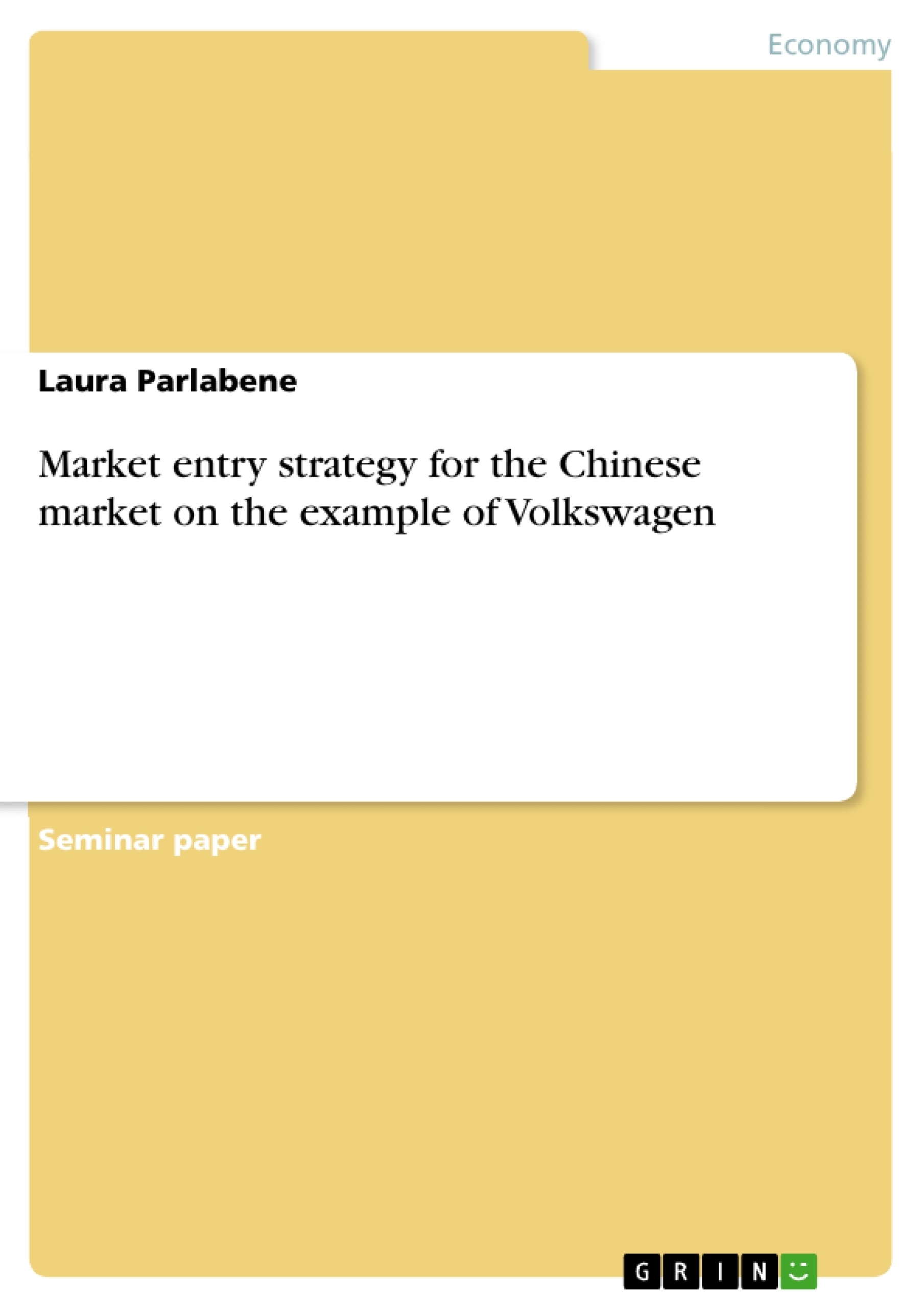Excerpt
Table of contents
List of tables
List of figures
List of abbreviations
1. Introduction
2. Theoretical basics of international market entry strategies
2.1 The term of international market entry strategy
2.2 Motives for companies to go international
3. Strategies to enter the Chinese market
3.1 Significance of the Chinese market
3.2 Timing of market entry: When to enter?
3.3 Location of market entry: Which market to enter?
3.4 Form of market entry: How to enter?
3.4.1 Representative Office in China
3.4.2 Chinese Joint Venture
3.4.3 Wholly owned subsidiary
4. Case study Volkswagen
4.1 Short profile of Volkswagen
4.2 Market entry strategy of Volkswagen
5. Conclusion
Bibliography
Appendix
Statutory Declaration
List of tables
Table 1: Advantages and disadvantages of
List of figures
Figure 1: Importance of countries in companies’ investment plans
Figure 2: Waterfall Strategy and Sprinkler Strategy
List of abbreviations
Abbildung in dieser Leseprobe nicht enthalten
1. Introduction
During the last years the globalisation has increased the competition amongst the companies and made them more willing to enter foreign markets. Developing a market entry strategy is very complex and has long-term consequences for a company. Thus, choosing an adequate market entry strategy has an enormous importance.
The present term paper is concerned with international market entry strategies especially for the Chinese market on the example of Volkswagen.
In chapter two some theoretical basics of international market entry strategies are provided. In this sense, the term of international market entry strategy is defined and the motives for companies to enter foreign markets are analyzed.
In chapter three the development of a market entry strategy for the Chinese market is examined. Therefore, the significance of the Chinese market will be shown at the beginning. Afterwards, the timing and the location of market entry will be explained. Finally, three forms of market entry will be presented.
The fourth chapter creates a practical connection of the topic by explaining the market entry strategy of Volkswagen.
2. Theoretical basics of international market entry strategies
2.1 The term of international market entry strategy
In the literature the term of international market entry strategy is often equated with the terms of internationalization strategy, international activities, and foreign engagement.[1] Thus, the term of international market entry strategy can be defined as an “institutional form of international business activity which allows a company to implement its business strategy in a foreign market”[2].
The international market entry strategy answers the question when and how to open up a certain market and it determines the form of the foreign engagement over an extended period of time. Because of its long-term, sustainable character, the choice of the international market entry strategy is the responsibility of the top-management. Some companies even have special departments that assist the management with the planning and development of the international market entry strategy. For example, these departments spend a lot of time doing researches to help managers finding a potential location for a new plant, a suitable country for a product launch, or a good partner for a distribution network.[3]
At this point it is important to emphasize that the international market entry strategy is not defined only once but it needs to adapt to changing conditions inside the company and on the foreign market.[4]
2.2 Motives for companies to go international
There are many different motives leading companies to enter global markets. Four important of them are:
- Market opportunities
- Economies of Scale
- Economies of Scope
- Location advantages
These four motives will be explained in the following chapter.
Market opportunities:
By enlarging their business activities to new foreign markets, companies get the opportunity of internal growth and prospective profits.[5] Especially companies experiencing slower growth in their domestic markets are attracted to enter foreign markets, particularly rapidly growing emerging markets.[6] Also the low level of competition in foreign countries offers market opportunities and plays a role in the companies’ decision to go international.[7]
[...]
[1] Lentzsch, A. (2006), p. 27.
[2] Junglen, I. (2005), p. 5.
[3] Lymbersky, C. (2008), p. 23.
[4] Lentzsch, A. (2006), p. 28.
[5] Tielmann, V. (2010), p. 2.
[6] DePamphilis, D. M. (2012), p. 659.
[7] Yu, M. (2009), p. 54.
- Quote paper
- Laura Parlabene (Author), 2012, Market entry strategy for the Chinese market on the example of Volkswagen, Munich, GRIN Verlag, https://www.grin.com/document/204369
Publish now - it's free






















Comments